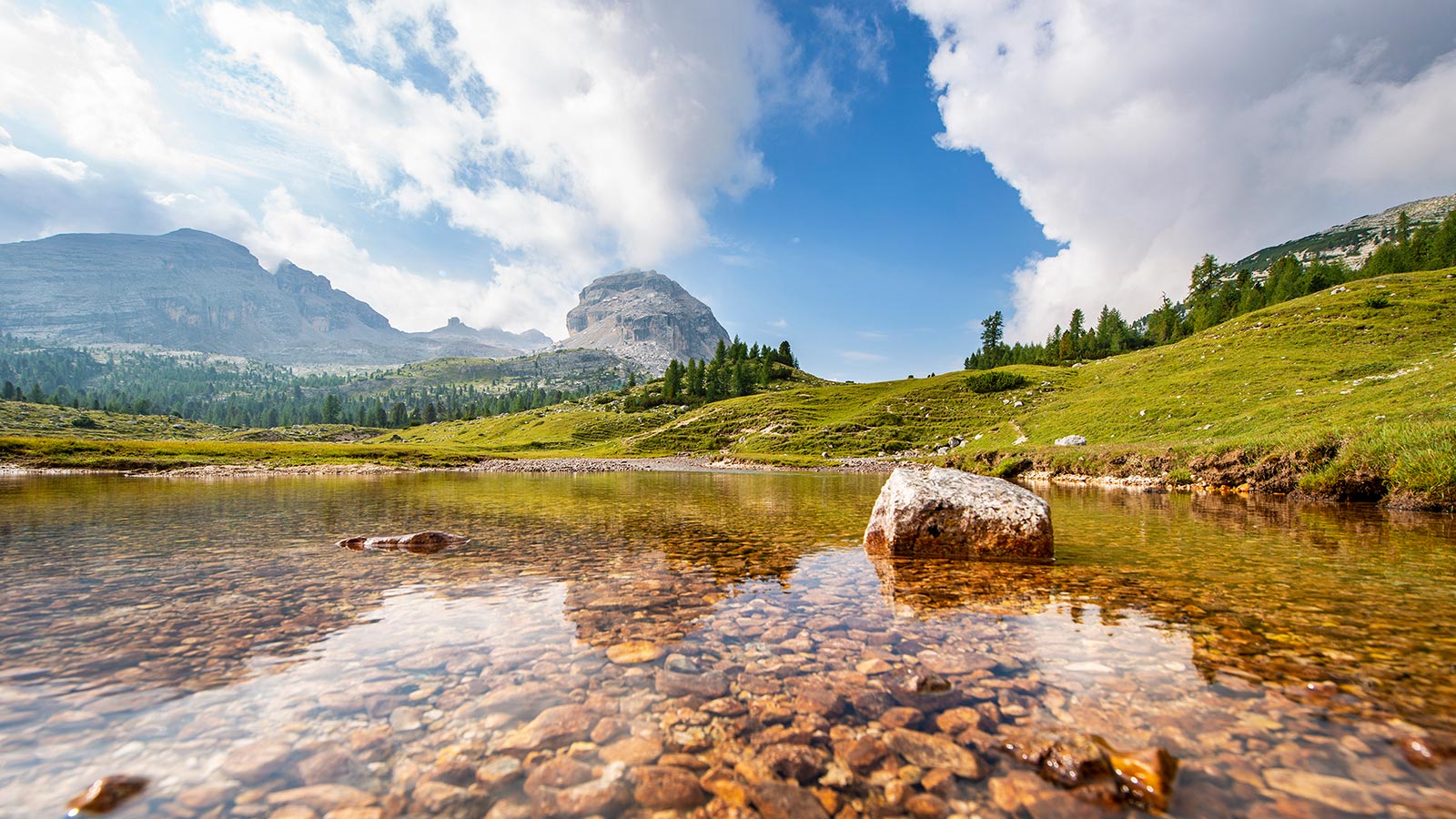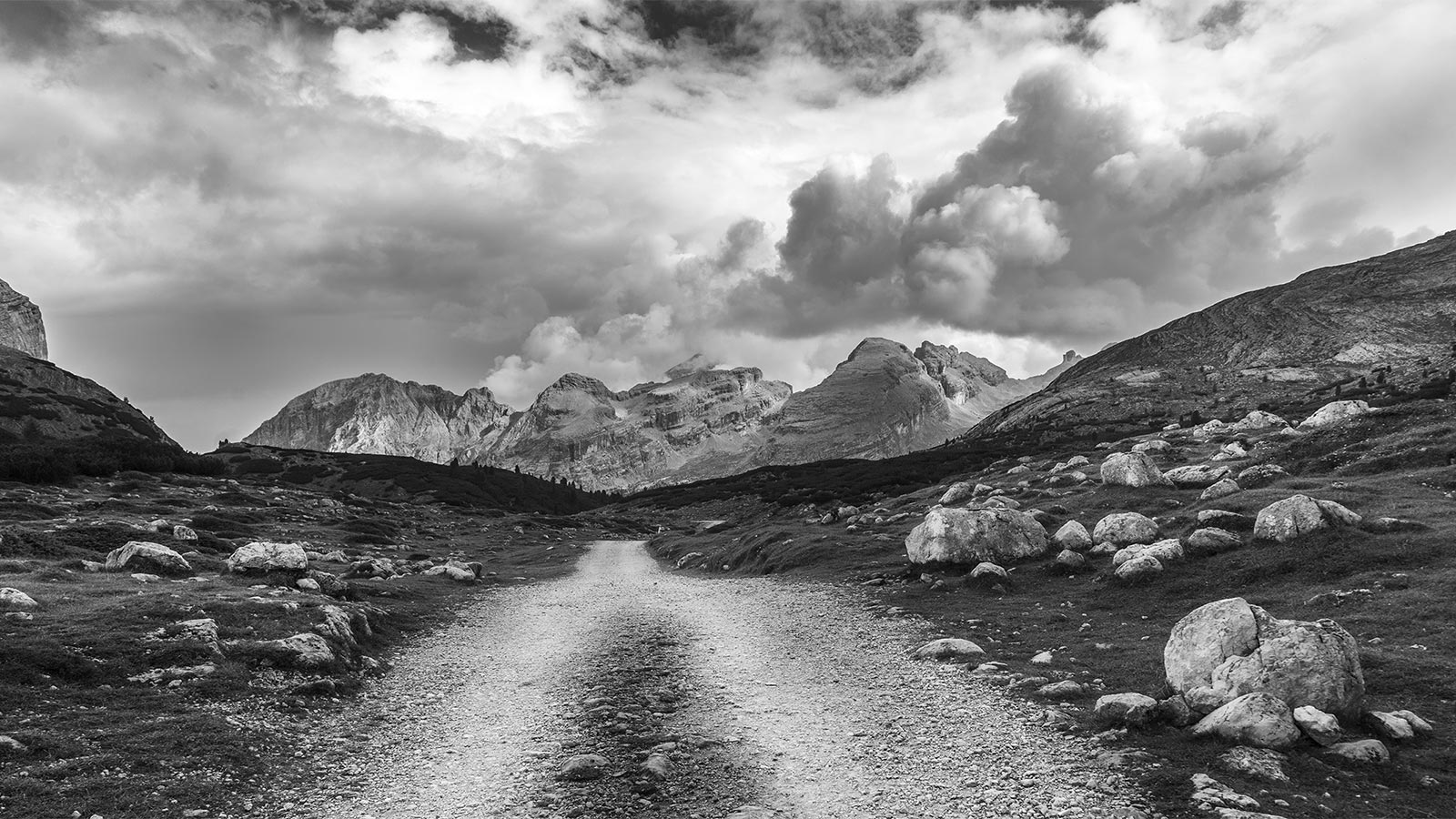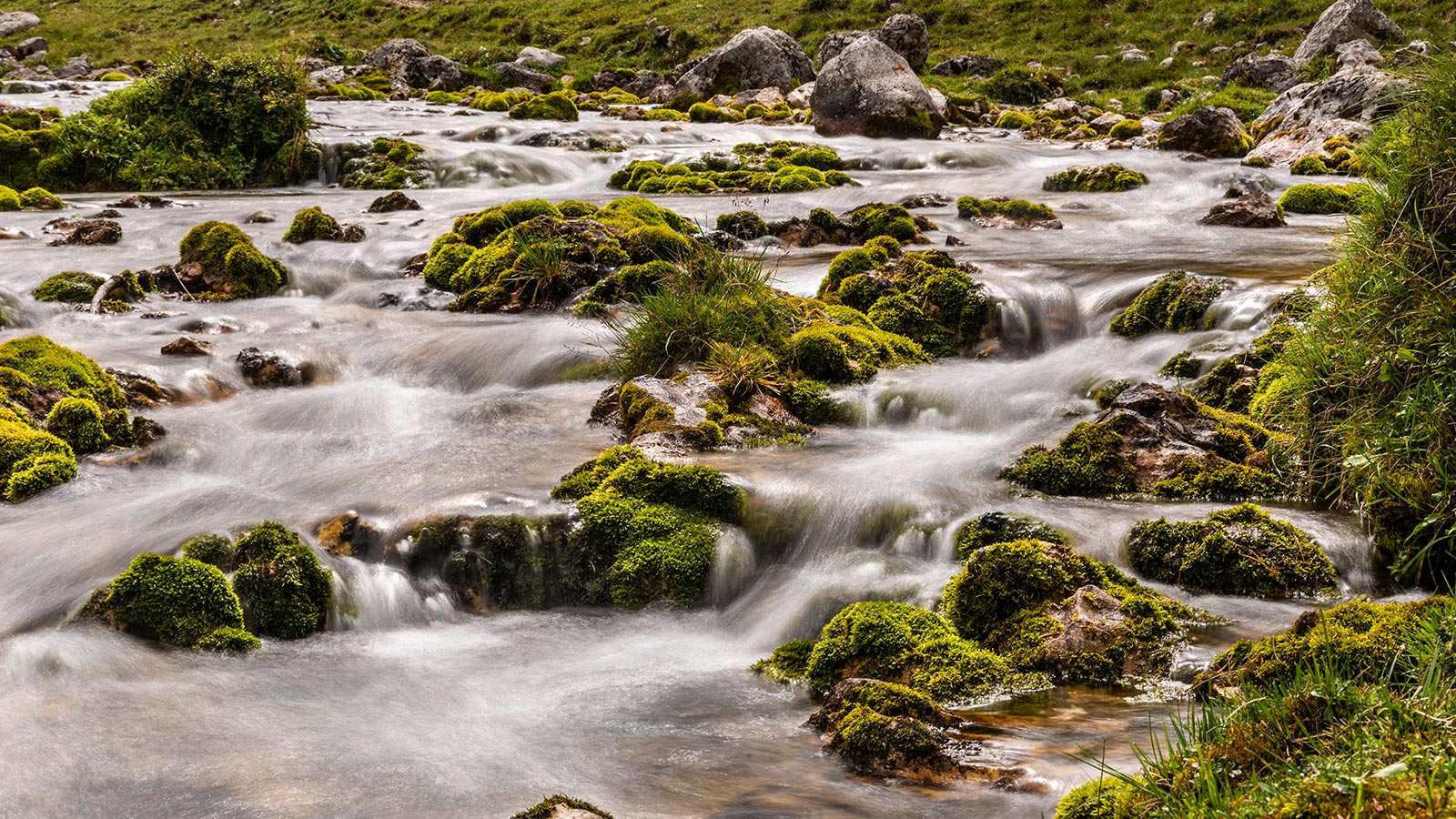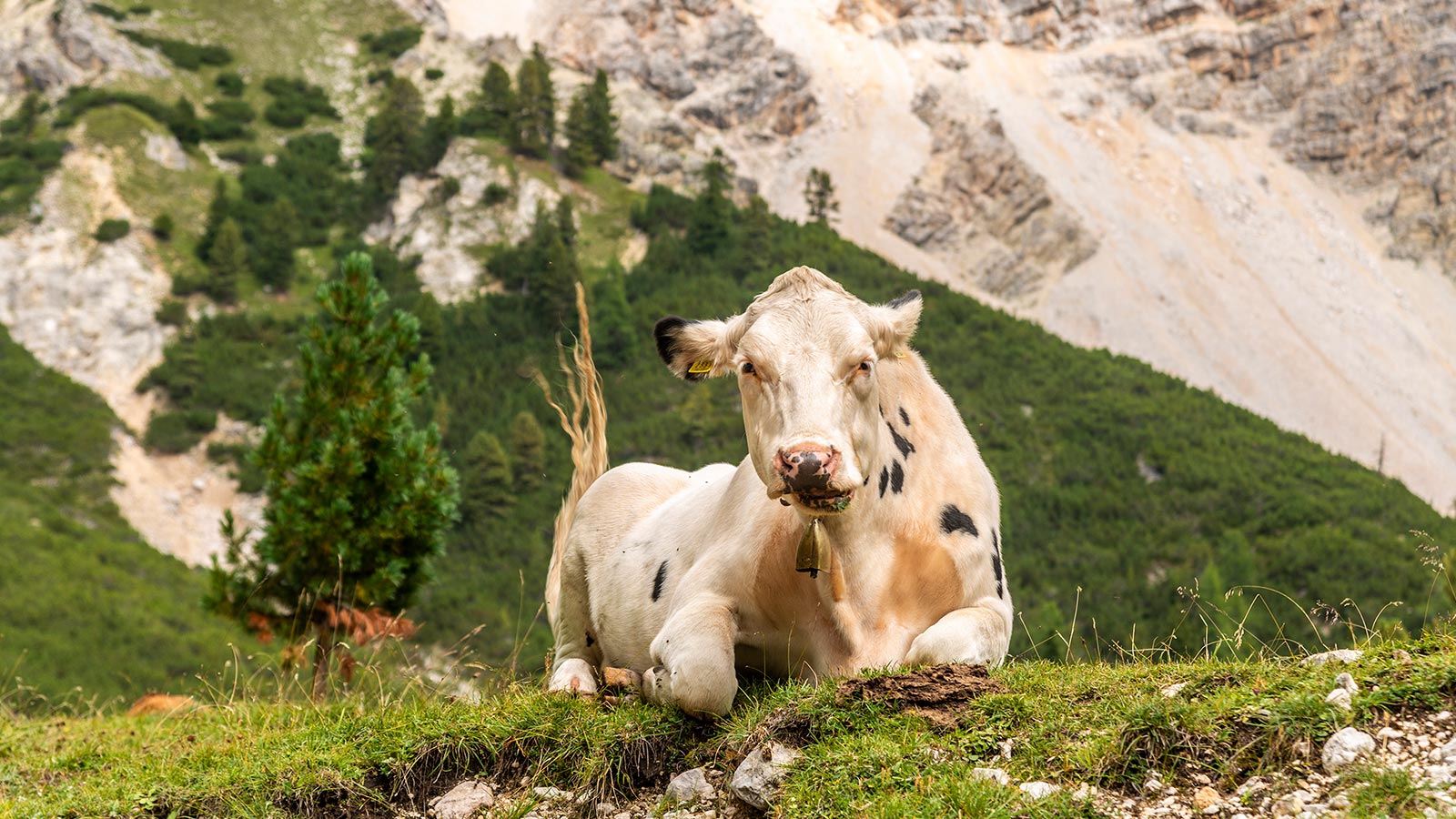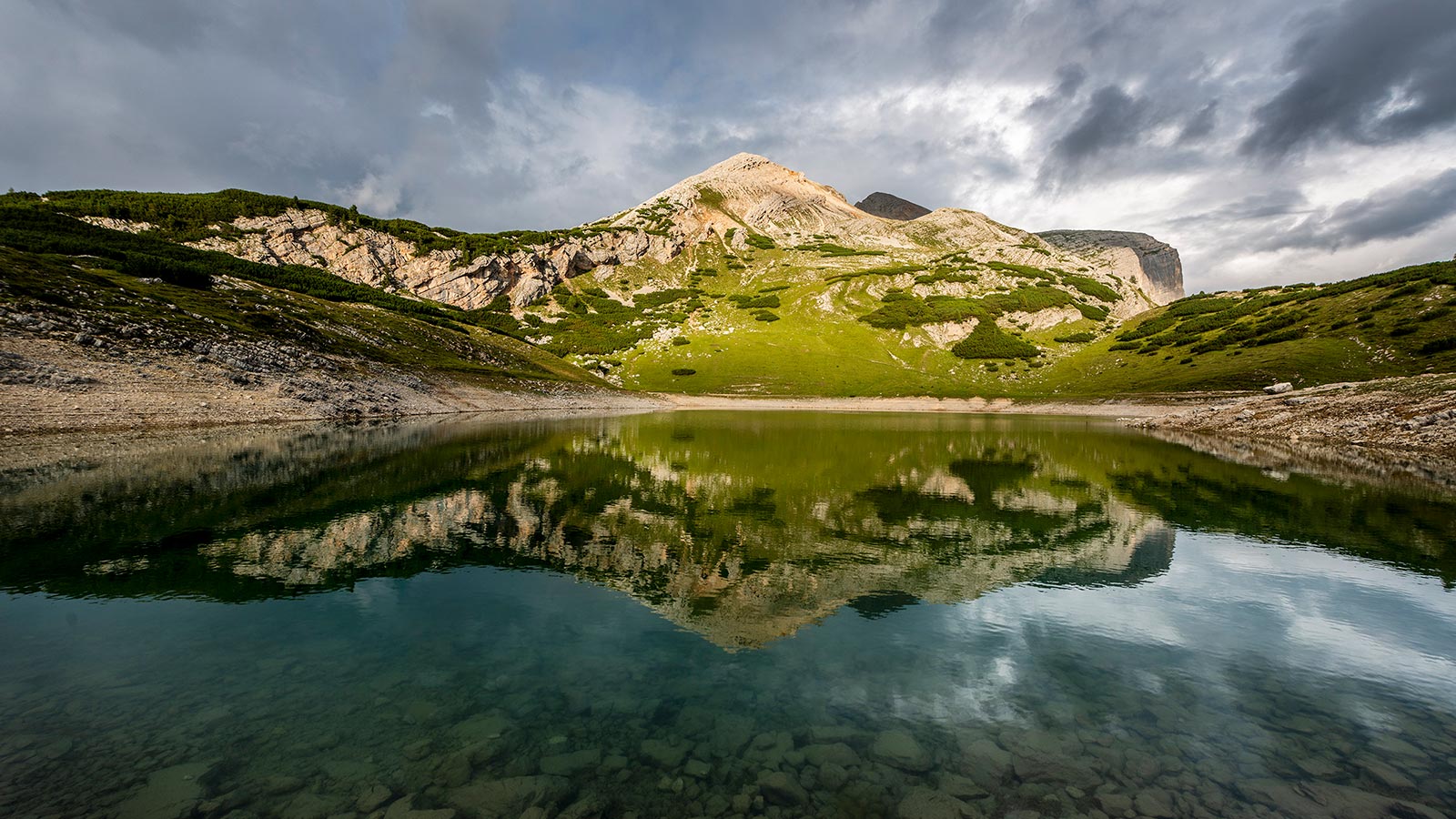A hut in Fanes Sennes Braies Natural Park
General information
The Fanes Senes Braies Natural Park was established in 1980 by the Province of Bolzano. It extends across a surface of 25,680 hectares and comprises the villages of: Badia, Braies, Dobbiaco, La Valle, S. Vigilio di Marebbe and Valdaora. It is therefore one of the largest Natural Parks in the region.
To the north the park boarders with the Puster Valley, to the east with the Landro Valley, to the south with the province and the region of Veneto and to the west with the Badia Valley. The entire park area is part of the Dolomites.
The Dolomites
Due to their structure and their composition, the Dolomites are unique in the world. Their origins date back to over 200 million years ago. Some 200 million years ago in a shallow sea which geologists refer to as Tetide, coral reefs began to form in the warm, agitated waters. With the impact of the African and the European continents approx. 200 million years ago, the sea bottom was gradually lowering, the coral, seaweed and a myriad of other tiny organisms continued to raise their constructions in order to stay close to the light. It was this rising of the sediments which formed the Dolomites. This movement has still not concluded, we can however not foresee it. Over the course of millions of years, the mountains were exposed to thunderstorms and the various ice ages. Due to this exposure, the rocks were slowly worn down layer after layer through the impact of water, ice, and wind. This is how the bizarre shapes, that often fascinate us so much, were formed.
The mountains in the Fanes - Senes- Braies Natural Park mainly consist of Dolomite, which is a limestone, less soluble to water than others. Fossils, which give evidence of the presence of the before mentioned micro-organisms, can be found in all the park's mountains.
The name "Dolomites" appeared almost 200 years ago. These mountains received their name in honour of the French geologist Deodat de Dolomieu. He was the first to get this type of limestone analysed and then established a chemical formula: calcium magnesium carbonate.
The phenomenon of karstification
This is the most typical phenomenon in the park and it also attracts the most interest. The Fanes- SenesBraies Natural Park is the most affected area in terms of karstification.
Karstification applies almost exclusively to easily soluble limestone, as it can be found on the Fanes Senes Fosses plateaus, and not to Dolomite. The carbonic acid dissolved in water has corroded and dissolved most parts of the existing Jurassic limestone and has thereby shaped these fascinating mountains. Almost all of the classic shapes of karstification can be seen here: grooves, crevices, fissures, shafts and dolines, which are small sinkholes in which alpine lakes often form permanently or more often temporarily.
Water in the Natural Park
Due to the karstification in this area, the Dolomites in Fanes and Senes are mainly characterized by sub-terrain drainage, while a normal water flow above ground can be observed in the Dolomite area in Braies.
During excursions in the natural park many lakes can be admired (Limo Lake, Parom Lake, Piciodel Lake, Fojedöra Lake, Colli Alti Lake). Two of the lakes deserve more attention, since they are located in the valley bottom and fill sediments originating from the ice age: Braies Lake and Dobbiaco Lake.
Last but not least we would like to mention Lé Vert (Verde Lake), which is the only lake with a tributary and outlet system.
Visitor's Centre: Via Caterina Lanz, 96 - 39030 San Vigilio di Marebbe. Phone: +39 0474 506120
Fauna and flora
The Fanes Senes Braies Natural Park can mainly be distinguished into two areas: the Braies Dolomites, where we find mountains like the Croda Rossa (3,146 m) and the area of the large Senes - Fanes - Fosses plateaus. These two really different landscapes provide the habitat for numerous birds, like the snow grouse, the Eurasian Capercaillie, the hazel grouse and the mountain cock, which prefers the areas of dwarf mountain pines and dwarf alpine rose bushes.
The forest belt mainly consists of red spruces, swiss stone pines, scots pines and larches. In the light mountain forests we find a lush vegetation of bushes, like blueberries, red berries and alpine roses. Higher up, the forest becomes sparser and mainly consists of mountain pines. Deer, martens, foxes, ermines, alpine rabbits and squirrels live in these forests. Sometimes you can even see rare animals like sparrow hawks and goshawks.
The valley area is mainly dominated by fields and pastures, where many flowers like arnica, gentian, the knotgrass and the golden hawk's beak.
Above 2,500 metres vegetation changes radically. It becomes sparser. However, during the right time you might be able to admire beautiful plants like mountain avens, sheep's bit, alpine achillea, edelweiss and the papaveraceae.
Further up between crevices and fissures of the rocks we can admire the Dolomite rapunculus, the edelweiss, potentilla, the evergreen sedge or the saxifragaceae. Those who would like to observe some of the rarer animals, might be able to see an eagle or more likely a common raven. On the rocky slopes we find chamois and for a few years now, also ibex.
Worth a visit is the cave with the remains of an Ursus spelaeus, a cave bear. These animals died out around the Little Ice Age (between 50,000 and 30,000 years ago). The skeleton was discovered by an excursionist in 1987, when he wanted to explore the karst cave.
Visitor's Centre: Via Caterina Lanz, 96 - 39030 San Vigilio di Marebbe. Phone.: +39 0474 506120
List of protected plants:
- Pulsatilla: all local kinds (Pulsatilla spp.)
- Aquilegia di Einsele (Aquilegia einseleana)
- Snowdrop (Leocojum vernum)
- Martagon lily (Lilium martagon)
- Orange lily (Lilium bulbiferum)
- Orchid: all local kinds (Orchidaceae)
- Daphne: all local kinds (Daphne spp.)
- Carthusian pink (Dianthus carthusianorum)
- Dittany (Dictamnus albus)
- Primrose: all local kinds, except for the cowslip primrose (Prinula spp. except Primula veris)
- Cyclamen, spring sowbread (Cyclamen purpurascens)
- Alpine thrift (Armeria alpina)
- Gentian and gentianella: all local kinds (Gentiana spp.)
- Yellow iris (Iris pseudacorus)
- White water lilly (Nymphaea alba)
- Typha: all local kinds (Typha spp.)
- Yellow water lilly (Nuphar luteum)
- Devil's claw (Physoplexis comosa)
- Alpine forget-me-not (Eritrichium nanum)
- Thousandleaf (Achillea oxyloba)
- Edelweiss (Leontopodium alpinum)
- Alpine wormwood (Artemisia mutellina)
- Butcher's broom (Ruscus aculeatus)
List of protected animals:
Mole (Talpa europea)
- Hedgehog (Erinaceus europaeus)
- Dormouse (Muscardinus avellanarius)
- Garden dormouse (Eliomys quercinus)
- Grass snake (Natrix natrix)
- Dice snake (Natrix tessellata)
- Western whip snake (Coluber viridiflavus)
- Aesculapian Snake (Elaphe longissima)
- Smooth snake (Coronella austriaca)
- Slow-worm (Anguis fragilis)
- Sand lizard (Lacerta agilis)
- Green lizard (Lacerta viridis)
- Viviparous lizard (Lacerta vivipara)
- European wall lizard (Lacerta muralis)
- European tree frog (Hyla arborea)
- Common toad (Bufo bufo)
- Green toad (Bufo viridis)
- Yellow-bellied toad (Bombina variegata)
- Green frog (Rana esculenta)
- Common brown frog (Rana temporaria)
- Fire salamander (Salamandra salamandra)
- Alpine salamander (Salamandra atra)
- Alpine newt (Triturus alpestris)
- Common newt (Triturus vulgaris)
- Crested newt (Triturus cristatus carnifex)
- Copse snails: all kinds (i.e. edible snails) (Helicidae for example Helix pomatia)
- Wood ant (Formica rufa)
- Praying mantis (Mantis religiosa)
- Noble crayfish (Astacus astacus)
Legends
The Fanes Empire
A long time ago on the high Conturines, where now only bushes and rocks can be seen and in an area, which is still called the "Marmot Parliament" was an empire with an enchanting town and villages with cultivated fields. This village was called Fanis and its inhabitants were called Fanes. Fanis had valleys and mountains, rivers and lakes and forests and was very big.
The population of Fanes had a queen, who lived in the castle on the mountain. The castle was protected by three wall belts. The people in Fanis were peaceful and wise and the marmots were their allies. The neighbouring populations said, that the Fanes got so powerful because of this alliance with the marmots, which was a big secret. The queen got to know about this alliance on her wedding night. The last princess of Fanes got married to a foreign prince. When she found out about how humiliating the origins of the great empire were, she did not have the courage to inform her spouse.
The princess refused to reign and so the foreign prince was elected king of Fanis. One day, the king went hunting on the Nuvolau. He managed to catch an eaglet. Suddenly an eagle with a fire bill and golden claws appeared. After a hard, but even fight the eagle said: "Give me back my son and I will make you the most powerful king in the mountains." The king agreed and the eagle proposed an alliance pact, which would be consolidated by the exchange of twins, should twins be born. In reality the eagle was the king of a far island, the king of the one-armed men. Some time later twins were born in the castle: Dolasila and Luianta.
The morning after, instead of Luianta, a white marmot was in the cot.
The queen prohibited her maids from informing the king about what had happened. A few days later the king told the queen that he would like to bring the twins up a high mountain in order to introduce them to the sun, the ruler of all life. He called a squire and ordered him to bring the twins to the bottom of Nuvolau, where an eagle would supposed to come to choose one of the twins. The squire was further ordered to tell the queen that one of the children was robbed on the way back to the castle.
When dawn was breaking, the squire left for the Nuvolau. The twins were wrapped up in blankets, so nobody would see them. He finally reached the bottom of Nuvolau. Suddenly an eagle with a fire bill grabbed the stranger looking twin and left as quick as he came. When the eagle had almost reached the peak he took a break on a rock and opened his bill and his wings.
The little marmot took the chance and ran away to hide in a rock fissure. On the way back to the castle the squire heard the scream of Spina de Mul, a sorcerer, who looked like a half rotten mule. The scream drove everyone who heard it crazy . The squire spent the night together with the Fanes warriors, who controlled the borders. Suddenly they heard steps. A youngster from the village of the Durannes appeared. Due to his adventures he would later be honoured with the name warrior. The young Duranne was curious to know who Spina de Mul was, who the man was that robbed the Fanes of their greatest treasure: the Raieta stone.
And Spina de Mul arrived. The brave Duranne hit Spina de Mul with a stone and the sorcerer fell to the ground screaming. Spina the Mul tried to flee, but the Duranne warrior followed him and hit him again. For this heroic gesture the young warrior was named Edl de Net (Eye of the Night). During his fight with Edl de Net the sorcerer lost his precious Raieta. One of the Fanes warriors said to Edl de Net: "Now you really are a great warrior. You have earned your name by combating a superhuman force and now you are in possession of the stone, the biggest treasure of the Fanes. Anything you wish for from the Fanes empire will be granted to you."
While everyone was admiring this mysterious stone, Dolasila started crying. Edl de Net showed her the Raieta and suddenly the baby stopped crying and held the precious stone really tight. "if this is your princess," Edl de Net said, "than this is her stone and I will give it back to her."
The squire returned to the castle and told the queen that the second twin was robbed on the way back to the castle. The queen however, did not say a word. The king was informed about what really had happened. One evening, while the king was riding to the Senespastures, the eagle with the golden claws came down from the sky to adhere to the pact. He handed a young eagle over to the king. On the way back to the castle the king's horse fell and the young eagle managed to fly away. Full of delusion the king returned to the castle. Here, good news awaited him: the queen had given birth to a prince. The baby was beautiful and very strong, but it only had one arm. The king organized a big feast and ordered the hoisting of the marmots flag and a flag with a red eagle in honour of his strong ally.
One day, the king heard an old storyteller talking about the splendid sub-terrain Aurona reign and the king was very impressed. The story about Aurona had such an effect on the king, that he immediately started looking for it. He heard about a lake above Canazei, the Silver Lake, where the people believed a huge treasure. The king went to the lake with Dolasila and his retinue. After digging for a long time, a soldier found precious jewellery and a small silvery box with white fur and some grey powder. Suddenly three dwarfs appeared in the cave and pleaded with the king not to take their treasure. The king didn't pay them any attention, but Dolasila felt sorry for the dwarfs and came back to return the box to them. The dwarfs smiled and asked Dolasila to throw the grey powder into the lake, as they were not allowed to do so.
The treasure would blossom out from the ground of the lake and the dwarfs would be freed. Dolasila was given the fur and the dwarfs told her: "Order the blacksmiths to make an armour out of it. Doing so, you will become an invincible warrior. But when the armour takes on a red colour, the colour of sunset in the Dolomites, then do not leave for battle."
When Dolasila returned to the castle the most skilled blacksmith made a very light, but very resistible armour out of the fur. With the silver, that strangely enough never finished, they made one bow for the warrior and twelve trumpets with a beautiful sound. After some time the king returned to the lake to see if it had blossomed as the dwarfs had promised. The entire lake was covered in silver reeds. One of the squires cut off twelve reeds, from which they made thirteen arrows for Dolasila.
The arrows were so powerful and so precise, that the king ordered the cutting of all the reeds, in order to have arrows for all the wars. The king had forgotten about Aurona, but he was taken by a passion for battle. Dolasila rode beside him. She was very proud of her white armour, her bow and her arrows. Her first victory was celebrated at Plan de Corones, because it was there, where the princess was crowned a warrior. One day, after a bloody battle, the princess was very sad, because she was thinking about the strange fate that made her bring death to other women like her. Even though Dolasila dreamed that the thirteen arrows would bring misfortune, she continued to battle and win.
Dolasila's undertakings and the anger over the loss of the Raieta stone angered Spina de Mul. The Lastoieres, who fought against the Fanes were beaten and humiliated by Dolasila. Spina de Mul was looking for allies to combat the Fanes Empire, but Fanes was very powerful: both, the Landris and the Caiütes were beaten. Then, Spina de Mul went to look for the prince of the Durannes, this Edl de Net, who once bet him below the Nuvolau. He managed to win Edl de Net over for his plan by talking about the arrogance of the king of Fanes and about the beauty of Dolasila. Edl de Net would take part in the war against the Fanes under one condition: Dolasila had to be spared. The allies met at the Boite. The Fanes also prepared for the battle. For the first time the one-armed prince would also participate in the battle.
The big eagle with the fire bill and the golden claws suddenly appeared from the sky. The Fanes recognized their ally. The battle was to take place on the Fiames pasture. Beside Edl de Net appeared Spina de Mul, dressed as a warrior. Suddenly the sounds of the trumpets of Fanes could be heard. Dolasila was in first line. After having beaten the Peleghetes and then the Lastoieres, the princess was facing the Durannes, while Edl de net was fascinated by the appearance of Dolasila. The two young people were immobilized. With lowered weapons they got lost in each others eyes. Right at this moment Spina de Mul threw one of his cursed arrows and hit Dolasila. The eagle prince grabbed her and brought her far away from the battle. The Durannes were however beaten. A water fairy at the shores of Antermoia Lake informed Edl de Net that Dolasila was forced into being a warrior and that she would often ride to the lakes to talk to the water fairies. She told them about how much she was in love with a warrior that she only saw once in her life. The fairy told Edl de Net that also the Fanes's destiny was sealed and that Dolasila was in danger. Edl de Net wanted to save her, but he didn't know how.
The water fairy advised him to go to the prince who had become a mendicant. The prince sent Edl de Net to Zicuta, Spina de Mul's sister, who hated the Fanes, because the king didn't want to marry her. Edl de Net had waited for seven days before the rocks suddenly turned dark and were covered by poppies as dark as blood. Edl de Net went closer and he saw the witch Zicuta. Zicuta told the noble Duranne that the reign of Fanes was damned. In reality Edl de Net was not interested in the Fanes empire, nor in its story or its destiny. He was only interested in Dolasila. "Ascend Latemar Mountain" said Zicuta "and ask the dwarfs to make a heavy shield. It has to be so heavy, that nobody else will be able to carry it, but you. With this shield you will defend Dolasila". Only a moment later the witch had disappeared and the poppies became black and turned into a small heap of ash.
Dolasila meanwhile was still injured in the Fanes castle. In order to be protected, she would need a shield that only the dwarfs at Latemar are able to make. The king travelled to Latemar and he was very surprised when the shield was ready before he had even ordered it. The king ordered that the shield be brought to the castle. Soon he saw that nobody was able to carry it. One day, a young foreigner arrived in the castle. He was able to lift the shield with only one hand. The king hired him as shield carrier for the protection of Dolasila during battles. The Fanes resumed combating and winning. Dolasila was in the first line, protected by the shield, which was carried by Edl de Net. The king was very surprised, when the young foreigner asked him permission to marry his daughter. The king's pride was injured. He would only agree to the marriage, if the young Duranne would confirm being a prince. Dolasila did not want to continue to fight, but the king could not get enough of war. In order to be the greatest king of his time, only the sub-terrain reign of the Aurona was missing. In order to come away with it, he started to hatch secret alliances with the surrounding populations. And Edl de Net got banned from the Fanes reign.
Dolasila promised her spouse, that she would not leave for a battle without him. The Fanes were confused and discouraged. The enemies had declared war and had lined up near Col di Lana. The queen called Dolasila and beseeched her to save the reign. The princess could not take a decision: the promise to her spouse was sacred, and so were her mother's words, sacred were her people, the Fanes. Dolasila had taken her decision, but her heart felt as heavy as a stone. For hours she rode around the fields of Armentarola hoping to meet Edl de Net. On the way back to the castle she met thirteen ugly and ruffled boys. Dolasila was afraid and gave one of her cursed arrows to each of the thirteen demons sent by Spina de Mul.
The princesses white armour turned dark like blood and Dolasila remembered the dwarfs' prophecy. Now she knew that her destiny was sealed. So, the princess of Fanes led her people to death. The Caiütes, the Cadubrenes, the Lastoieres, the Peleghetes, the Latrones and the Ampezzanes lined up on Pralongiá. The false king had managed to convince many people with his betrayal. It was nearly lunch time and the battle was still not in favour of the Fanes or the allies. Dolasila's armour was hidden under a coat, but on her forehead the Raieta was shining. So, the thirteen archers from Caiütes recognized her and they caught her with thirteen cursed arrows. The princess fell to the ground, beaten by her own arrows and calling for Edl de Net while she was dying. The hope of the Fanes empire was lost.
The king of Fanes was hiding at Lagazuoi lake, where he was waiting for the return of his allies. Suddenly the king was taken by nostalgia for his people. He wanted to return to the castle, but the allies kept him prisoner and laughed at him. He was a false king, who had betrayed his people and he therefore turned into stone. The mountain pass at the bottom of Lagazuoi is still called Falzarego Pass (False King). The last Fanes warriors managed to save themselves in the castle on the Conturines. Here, the queen was informed about Dolasila's death.
A young girl, dressed in white, suddenly appeared beside her. It was Luianta, the daughter that the queen had exchanged for the pact with the marmots, her secret allies.
The queen mother followed Luianta into a cave, where she begged for pardon for having abandoned the pact. She told the story about the alliance with the eagles and about how the marmot twin was exchanged. The marmots understood and forgave the queen. They agreed to renew the pact. Luianta brought the queen to Morin dai Salvans, where the few surviving Fanes were waiting for better times. This was the place below-ground, where the dwarfs processed gold and the marmots spent their hibernation. The enemies had destroyed everything the Fanes had ever built and the once blooming reign seemed a like a desert.
Spina de Mul personally guarded the thirteen arrows and the Raieta stone was hidden in a cave, which was guarded by the bears. Once a year, when the moon is shining, a black boat makes its rounds on the Braies Lake. It comes from a rock door and moves the immobile waters of the lake. On the boat are the old queen and Luianta. They wait for the sound of the silver trumpets, they wait for the hour of the promised times, the time in which the Fanes Empire will rise again.
The set of rules
On the territory of the Fanes - Senes- Braies Natural Park it is forbidden to:
- remove, damage or modify the Park signs and facilities: they were set up for your benefit and convenience;
- camp with tents, campervan or similar is forbidden. Camping is allowed in the alpine bivuouac;
- it is forbidden to light fires, with the exception of those authorized for legal forestry and agricultural activities;
- motorized vehicles are forbidden in the park;
- do not alter the landscape by leaving solid waste of any kind;
- do not leave behind bottles, tins, card residues, plastic or any other kind of waste;
- do not disturb the peace of park wildlife with unnecessary noise; authorized activities excepted;
- mushrooms, even if not edible, may not be gathered or damaged;
- likewise protected is the Park fauna: do not pester the animals, big or small, leave their dwelling, brooding and feeding places alone excepted from this rule are activities, which are necessary for normal agricultural use;
- do not alter the appearance of the landscape, which represents a typical habitat for animals in these areas;
- any alteration or modification to the paths in the park is forbidden;
VIEW COMPLETE TEXT (In Italian or German language)
